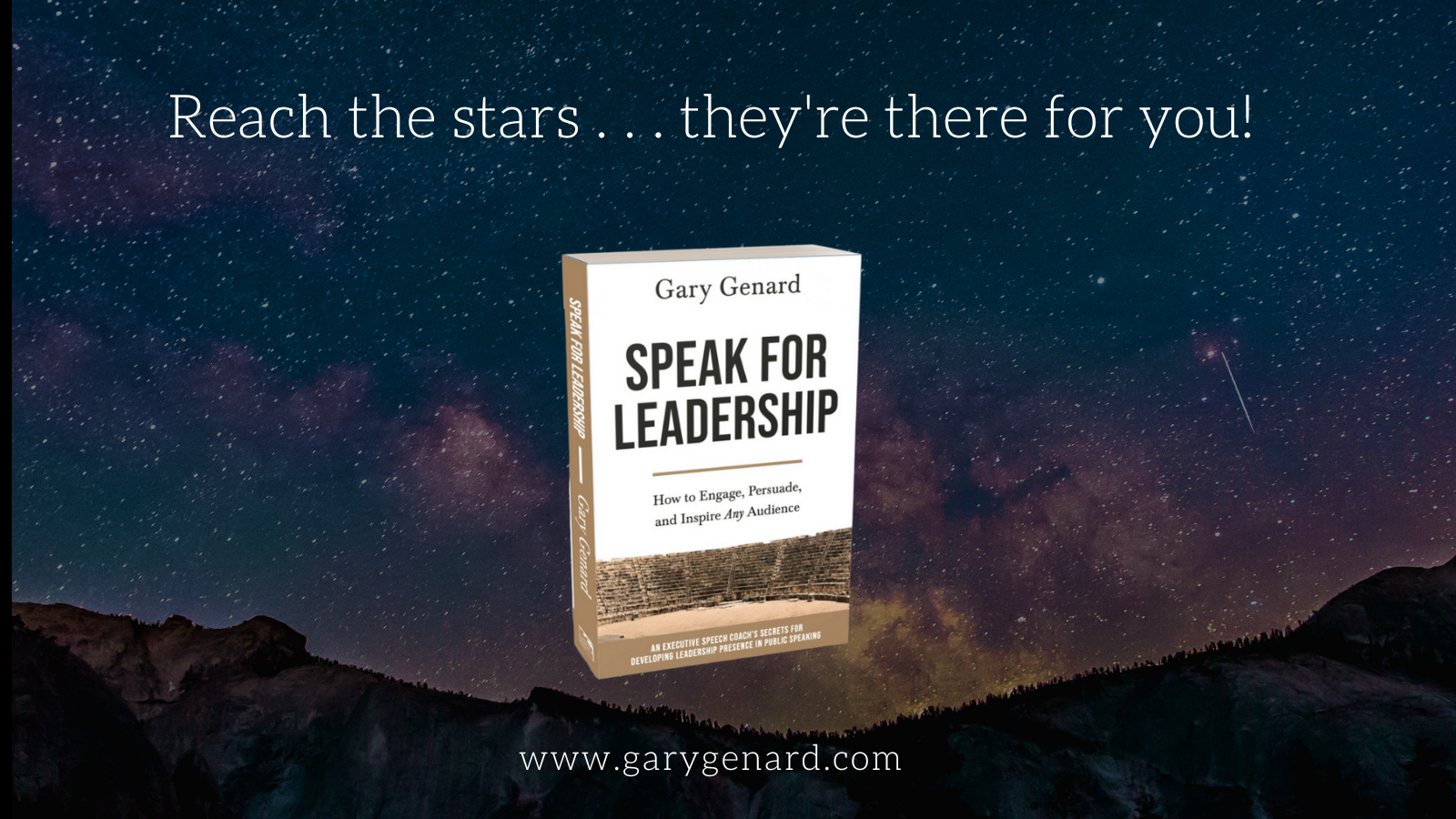Do audiences love you? When you're speaking, that should be the case in your relationship with them! Here's how to make that happen.
In a recent post, I discussed a client who was passionate about his company's work in the environmental sector, but who had a problem.
He wasn't coming across as particularly human. That is—it didn't seem like he cared much about his organization's mission, even though he cared deeply.
Is your passion showing? If you want to lead people, it has to! Learn more in my book, Speak for Leadership: An Executive Speech Coach's Secrets. Click below to learn more.
Remember, the speaking persona you display is the way you communicate your thoughts and emotions to others. It doesn't matter that the message is elegantly expressed in your speaking notes or manuscript. Or even that you know the rules for succeeding with PowerPoint. If you don't look and sound like you mean what you're saying, listeners won't buy your message.
Which was exactly the situation with my passionate—though unconvincing—environmentalist.
Are you too married to your content to be connecting with listeners? Download my free Insights guide, "Great Speaking?— It's About Performance Over Content."
In fact, it's never enough to simply convey the information you need to get across. When you speak in public, your job is to change lives in ways large and small. So, audiences don't need to merely accept you—they need to believe in you. There's no other way to truly get them to open up and be willing to be changed by you.
For the strongest interchange of both ideas and emotions to take place in the public speaking arena, a kind of love affair has to take place. Simply put, you need to love your audience, and for listeners to be willing to be changed in significant ways, they have to return the infatuation. Here are four ways you can get the relationship going.
Be Real, Honest . . . and Vulnerable
To begin, avoid the mistake of playing it safe. A major reason most presentations are boring and sink without a trace, is that the speaker is intentionally doing what everybody else has done. If that's the accepted way presentations, lectures, pitches, and keynotes—or whatever flavor of talks—are done in these situations, well, it just makes sense to do your presentation the same way. Doesn't it?
It does not. Part of my speech coaching practice at The Genard Method is helping people overcome fear of public speaking. In almost every situation, speakers with stage fright try to defend themselves when they're on stage. Instead of standing out for visibility and acclaim, they'd rather stay under the radar and, basically, get out of the stressful speaking situation with their skin intact.
Don't play it safe. Make a difference! Learn how to command a stage. Get my Free ebook, High-Impact Speaking: The Leader's Guide to Presenting With Influence.
But you want to be recognized and applauded, don't you? That will never happen if you try to blend into the background, like every other presentation. Few things are as revealing as standing in front of an audience—just you—and sharing something that's dear to your heart. Being willing to show your true self, in all of your vulnerability, is the only way we'll trust you and like you. That's the you that's unique and therefore interesting! So, stake a claim.
Make Listeners Comfortable Using This Technique
Here's the perfect way not to be upstaged by your data and give listeners a comfortable feeling about you: Feed your content to the audience in bite-sized pieces.
Once again, most speakers don't consider the difference between written information and that same content delivered to an audience. Listeners (unlike readers) absorb information in precisely the time it takes to hear it. Your job is to make that easy for them. It's actually amazing how much data audience members can absorb if it's presented to them at the right pace.
It's part of speaking with presence, because you're literally "present" for your audience. Learn more in my Free ebook, 12 Easy Ways to Achieve Presence and Charisma.
Time and time again, I coach my clients to think of and deliver their talks segment by segment. Here's why that's important. Each section of your presentation is really a mini-talk, interesting and absorbable by itself.
But it's your responsibility to signal to the audience each time: "That's the end of THAT idea . . . here comes the next one." That way, listeners can take a mental breath, and be ready to absorb new information. The best way to do this is to pause, say something in the way of a transition, and inflect your voice as you start the next section. This gives the audience time to process what you've just talked about, and be ready for the new (and therefore interesting) segment that's coming.
For more on improving your voice for business presentations, download my Free Tips and Tricks Guide, "The Voice of Authority: How To Sound Like a Leader."
Tell Stories That Are All About Your Audience
Emotion is the currency that makes you likable and memorable for an audience, not data. While the information you impart may be essential for an audience to know, your lasting impact resides in how you make them feel. And that's certainly an important component of the love affair I mentioned earlier.
Here again, too many presenters misread the public speaking drama, casting themselves in the role of messenger. But that's only a starring role in ancient Greek theater (in early tragedy, violence always occurred offstage, and the messenger was the one who described it). If delivering data was all that mattered, why would we have invited you here to speak? Your content will do its job fine, but you have a different part to play. Think of it this way: your job isn't to deliver the goods. It's to create good.
Of course, you need to be interesting while all of this is going on. Go beyond information! Download my Free resource, "How to Be a Clear, Concise, and Compelling Speaker."
That requires an emotional connection, and that means storytelling. Understand, I don't necessarily mean telling stories—though you should be storing and sharing actual stories as part of your talks. What I really mean is delivering your information as a story.
Your overall presentation should always be a narrative of some kind, and you should weave your data into that story (e.g., "Our success in streamlining our operations, and the next challenge we're facing"). Also, look for ways to give pertinent information as a "little" story within your larger narrative, as I did above with the mini-lesson on the ancient Greek theater.
And remember: To make your story as powerful as possible, always frame it within the context of your audience's needs and desires. Ultimately your story, however universal you may think its message, is all about the people listening to you right now. The more they can identify your story with their lives, the more they will like—or even love—what you're saying.
Are You In a Human-to-Humans Relationship?
This is what your appearance comes down to in the end, and is the key to getting any audience to love listening to you. The essence of presenting is knowing how to give a great public speaking performance. What happens on stage should never be only about the transfer of information. It should always be about the transformation of people's lives.
You won't always, of course, be giving talks on grand themes that change society But the ways you will influence listeners' thoughts, emotions, and behavior, even if those ways are small, matter greatly. There's really only one way to make that happen: to get in there and mix it up, connecting with the folks in the seats and not just reading information to them.
Who Are You Talking To, Anyway? Recently, an audience member asked me a question along these lines at the end of a keynote speech I'd just delivered. "I've always heard that if you're nervous on stage," she said, "it's best to look at the back wall of the auditorium, so it looks as if you're speaking to the people in the back row. Is that a good idea?"
"That's a silly idea," I replied. The audience laughed at that, though I wasn't trying for humor. I went on: "Who do you think will be easier for you to convince: the wall, or your audience? The wall won't be able to listen to you, and it won't change as a result of what you're saying."
Then I finished my reply with a comment that might have had this article in mind: "And of course, the wall won't love you back."
This article is excerpted from my book, Speak for Leadership.
You should follow me on Twitter here.

Gary Genard is an actor, author, and expert in public speaking and overcoming speaking fear. His company, The Genard Method offers live 1:1 Zoom executive coaching and corporate group training worldwide. In 2022 for the ninth consecutive year, Gary has been ranked by Global Gurus as One of the World’s Top 30 Communication Professionals. He is the author of the Amazon Best-Seller How to Give a Speech. His second book, Fearless Speaking, was named in 2019 as "One of the 100 Best Confidence Books of All Time." His handbook for presenting in video conferences, Speaking Virtually offers strategies and tools for developing virtual presence in online meetings. His latest book is Speak for Leadership: An Executive Speech Coach's Secrets for Developing Leadership Presence. Contact Gary here.
Heart illustration: GDJ on Pixabay.




